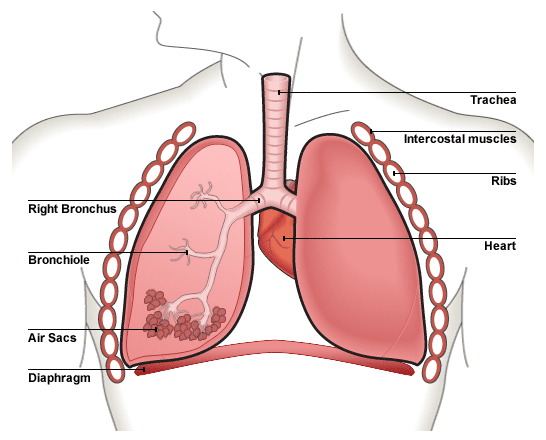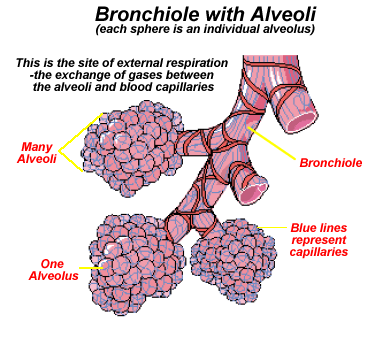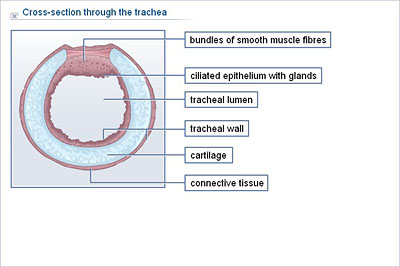The Lungs
Most mammalian lungs have the same basic structure. The Trachea (windpipe) leads from the mouth and nose and splits into the Bronchi which in turn split into the Bronchioles which lead to the Alveoli (air sacs) where gaseous exchange occurs.
These form a pair of inflatable structures, the Lungs, supported by the ribs and the Diaphragm which allow the animal to Inspire and Expire.

Inspiration and Expiration
- Inspiration (inhaling) and expiration (exhaling) are the processes by which the lungs take air from the environment, and put waste gases back into the environment. The processes are controlled by the diaphragm and the Intercostal Muscles (which run between the ribs).
During inspiration, the diaphragm contracts and pushes down the digestive organs beneath it. The external intercostal muscles also contract, pushing the ribs up and out. This increases the volume of the lungs, so that they have a lower air pressure than outside the body, causing air to rush in.
During expiration, the diaphragm relaxes and is pushed up by the displaced digestive organs. The external intercostal muscles relax, allowing the ribs to fall. This decreases the volume of the ribs which means that they have a higher air pressure than the outside, causing air to rush out.
Gaseous Exchange
The body needs Oxygen for respiration, and must excrete Carbon Dioxide. The exchange of these gases occurs in the alveoli.
The alveoli are small sacs, surrounded by capillaries, which are adapted for efficient gaseous exchange. Oxygen diffuses from the alveoli to the blood in the capillaries, and Carbon Dioxide diffuses from the capillaries to the alveoli.

Though each alveolus is small, the total surface area of all the alveoli in the lungs is large (about 70m2 in humans). This helps to increase the rate of gaseous exchange.
The walls of the alveoli are only one cell thick; those cells (and the cells making up the walls of the capillaries) are specialised Squamous Cells: they are very thin. The capillaries are also very close to the walls of the alveoli. These factors decrease the diffusion distance, and hence increase the rate of gaseous exchange.
In order to maintain a steep diffusion gradient, air must be removed from the alveoli, and blood must removed from the capillaries surrounding them. This is done by expiration and by the action of the heart pumping blood around the body.
Another adaptation to the task of efficient gaseous exchange is that the capillaries surrounding the alveoli are so thin that only one red blood cell may pass through at a time. This slows down the blood cells, meaning that more exchange of gases can occur, and it also pushes them closer to the walls of the capillaries, decreasing the diffusion distance.
The Structure of the Lungs
- The trachea, bronchi, and bronchioles are well adapted to their tasks. They are composed of different tissues, each of which performs a different function.
The Trachea and Bronchi
- The trachea and bronchi have very similar structures, their main difference is size.

The outer layer is made of Cartilage. This is relatively rigid (more than muscle, less than bone) and supports the trachea and bronchi, preventing them from collapsing when the air pressure inside them is low after expiration. The cartilage does not form a complete ring. This allows some flexibility, for example allowing the Oesophagus to expand when swallowing food.
The next layer is composed of Glandular and Connective Tissues, Smooth Muscle, Elastic Fibres and blood vessels.
The smooth muscle allows the Lumen (the inside space) to constrict, by contracting. This is useful if there are harmful substances in the air, as is minimises the amount of the substances that can be breathed in.
The elastic fibres allow the lumen to Dilate (widen) after the smooth muscle has contracted and then relaxed.
- Finally, the inner lining of the trachea and bronchi is a layer of Ciliated Epithelium containing Goblet Cells. Ciliated epithelium consists of cells with Cilia. The glandular tissue and goblet cells secrete Mucus, which is then wafted up the airways by the cilia which move in a synchronised pattern. The mucus traps harmful substances and organisms, preventing them from entering the lungs.
The Bronchioles
- The Bronchioles tend to be narrower and have less cartilage than the trachea and bronchi. Their walls are mainly made up of smooth muscle and elastic fibres, though they still have a lining of ciliated epithelium.